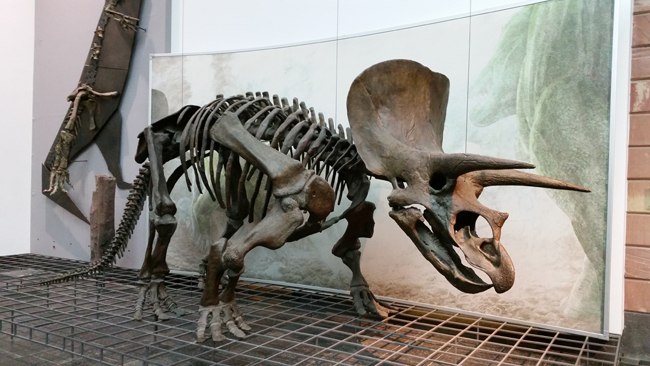Horned Dinosaur Skull Found in South Dakota Might Be New Species
The small town in Buffalo in the north-west of South Dakota was so named as back in the 19th century vast herds of buffalo (American bison), roamed across this part of the world. However, another type of horned animal has got local townsfolk excited, one that would have dwarfed even the largest of today’s hoofed giants, a very-well preserved partial skull and jaws of a huge horned dinosaur which might turn out to be a new species.
Acquired from a Fossil Collector
Fossil collector and dealer Alan Detrich purchased the dinosaur skull found in Harding County from another fossil collector John Carter back in 2012, but it has taken more than two and a half years to prepare the specimen ready for sale. When the fossil skull and lower jaw were first excavated it was thought that the bones represented a very large specimen of Triceratops (T. horridus). However, with the fossil completely exposed, Alan along with Neal Larson (Larson Paleontology Ltd) who was tasked with preparing the fossil, believe that this could be a brand new species of horned dinosaur.
Over the last fifteen years or so, a number of new North American horned dinosaurs have been named and described, however, if proved to represent a new species, this dinosaur skull could be heralded as one of the most spectacular dinosaur discoveries of all, the nasal horn alone measures nearly forty-five centimetres long and the skull itself is over 1.82 metres in length.
Ceratopsian Skull
Commenting on the unusually large nasal horn, Alan Detrich stated:
“They are [Triceratops nose horns] usually half that size and the skull is eight feet long, which would be a monster skull for a Triceratops.”
Neal Larson, the founder of Larson Paleontology Unlimited and a co-founder of the Black Hills Institute of Geological Research with his brother Pete Larson, who coincidently is also working on a centrosaurine specimen at the moment, was given the task of trying to prepare the specimen. It took over 1,000 pain-staking hours to carefully excavate the fossil from its iron siderite matrix. The preparation work was extremely difficult, as despite the robust nature of the fossil bones, the matrix with its iron component (iron carbonate) was extremely hard.
A Ceratopsian Exhibit at a Museum (Triceratops)

A cast of a Triceratops skeleton on display at the Naturmuseum Senckenberg (Natural History Museum – Frankfurt). On the left a wall mounted example of a Plateosaurus can be seen. Is the Buffalo skull a new species?
Picture credit: Everything Dinosaur
For articulated models of ceratopsians and other dinosaurs: Beasts of the Mesozoic Articulated Dinosaur Models.
A Large Centrosaurine Skull
A spokesperson from Everything Dinosaur exclaimed:
“It’s only when you see a person stood next to the beautifully preserved skull that you can really appreciate just how big the animal actually was. This is certainly one of the largest centrosaurine skulls that we have seen.”
For Neal, who holds a degree in geology and has been excavating fossils for some forty years now, the ceratopsian skull represented a tough challenge given the hardness of the surrounding matrix.
He stated:
“I immediately had my suspicions this was something new because of the size and placement of the nasal horn. They’re usually in the middle of the nose, not the front and it’s twice as large as most of them. On top of that, the frill at the top of the skull curves upward. They usually lay back.”
Ceratopsian Skull Could Represent a New Species
The skull has a strange ridge under the jaw, something that is not seen in Triceratops skull material. Mr Detrich is now trying to find a museum to house this specimen, preferably in the United States, potential buyers for this huge dinosaur skull are currently being contacted.
The Ceratopsians of North American seem to have evolved into a very diverse range of forms during the Late Cretaceous. Some of the skulls of these herbivorous dinosaurs were truly immense. As a clade, the ceratopsians are considered to have the largest skulls in proportion to the rest of their bodies of any known vertebrate. A few years ago, Everything Dinosaur reported on the discovery of another enormous horned dinosaur skull, this time from Alberta, Canada, a dinosaur that was believed to be an ancestor of Triceratops.
To read about this fossil discovery: Enormous Skull of Eotriceratops Discovered.





